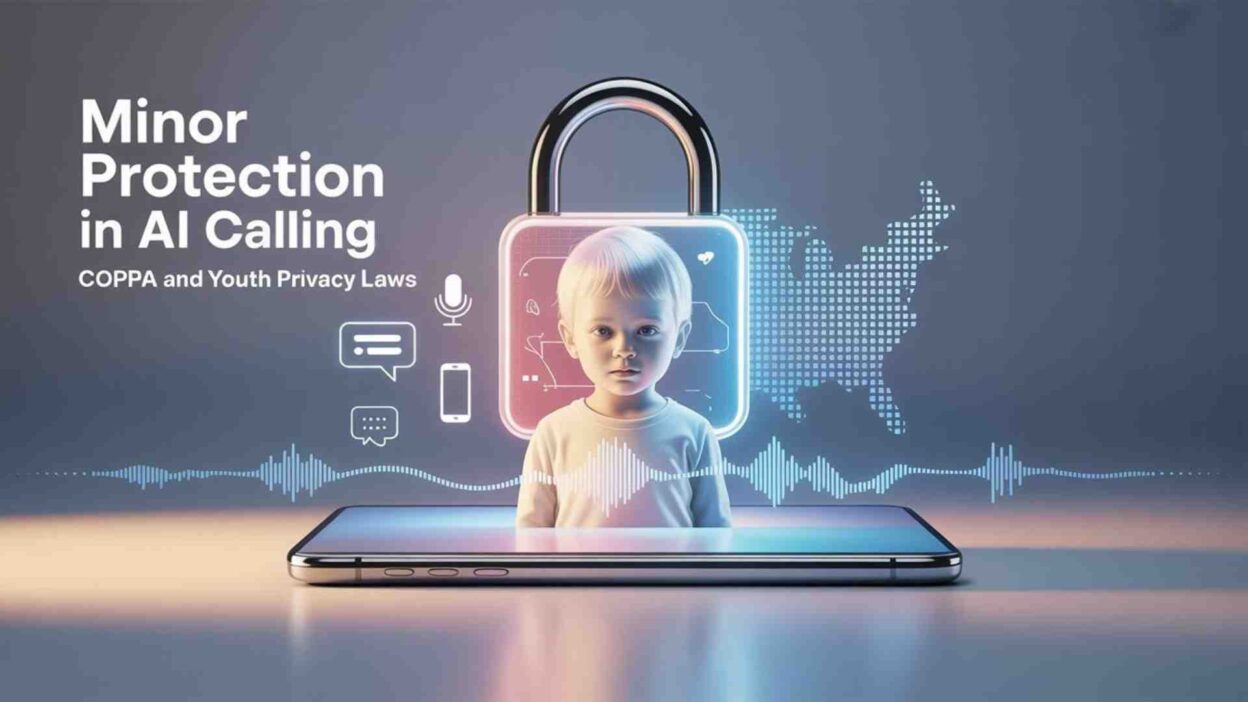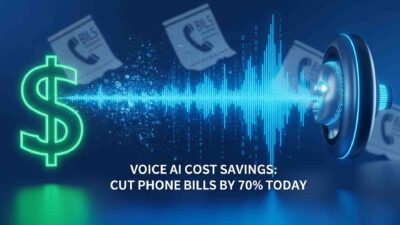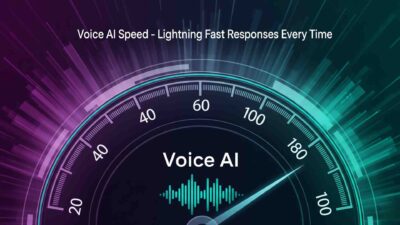TL;DR AI calling minors compliance creates unprecedented challenges for businesses deploying voice automation systems. Companies using AI voice bots face complex child protection regulations that can result in devastating penalties and permanent market exclusion.
Table of Contents
What Nobody Tells You About Voice Bot Child Protection Laws
You’ve probably seen countless articles promising “simple AI compliance” and “easy voice automation deployment.” Here’s what they don’t mention about the regulatory minefield surrounding children and automated calling systems.
After extensive research into COPPA violations and consulting with child privacy experts, I’m sharing the unfiltered truth about voice bot child protection requirements. This isn’t another generic compliance guide filled with legal theory. This is the reality check you need before your AI calling system faces crushing penalties for minor-related violations.
Child protection laws aren’t just privacy regulations. They represent society’s strongest legal safeguards with the harshest penalties. Voice bots that interact with minors enter the most dangerous territory in business law. Every automated conversation with a child creates potential liability exposure.
Understanding COPPA’s Impact on AI Calling Systems
The Children’s Online Privacy Protection Act governs how businesses collect information from children under 13. COPPA applies to voice bots that knowingly collect personal information from minors. The law treats voice recordings as personal information requiring strict protection.
COPPA Definitions That Affect Voice Bots
Personal Information in Voice Interactions Voice recordings themselves qualify as personal information under COPPA. Background conversations may capture additional family members. Phone numbers and calling patterns create detailed profiles of children’s activities.
Names mentioned during voice bot conversations require COPPA protection. Home addresses disclosed during calls need special handling. School information and friend names fall under personal information definitions.
Actual Knowledge Standards Voice bots gain actual knowledge when children identify their age. Direct age collection triggers immediate COPPA obligations. Indirect age indicators also create compliance requirements.
Voice pattern analysis that identifies children creates actual knowledge. Systems that detect young voices must implement COPPA protections. AI calling minors compliance becomes mandatory once age awareness exists.
Constructive Knowledge Requirements Websites and services directed at children automatically trigger COPPA. Voice bots serving educational content for kids qualify. Entertainment services targeting minors need full compliance.
Mixed-audience services require age screening mechanisms. General audience voice bots must identify child users. Failure to screen creates liability for all minor interactions.
Parental Consent Requirements for Voice Bots
Verifiable Parental Consent Methods COPPA requires verifiable parental consent before collecting children’s information. Voice bot child protection demands explicit parent approval. Several consent methods meet COPPA’s verification standards.
Signed consent forms provide the strongest legal protection. Credit card verification offers convenient digital consent. Government ID verification ensures parent identity confirmation.
Email plus additional verification steps create acceptable consent. Phone verification combined with written confirmation works. Video chat verification allows real-time parent identification.
Ongoing Consent Management Parents can revoke consent at any time during voice bot interactions. Systems must immediately stop data collection upon consent withdrawal. Existing data may need deletion depending on circumstances.
Voice bots need clear consent withdrawal mechanisms. Parents must understand how to stop data collection. Emergency stop procedures should be available 24/7.
Regular consent renewal may be required for ongoing services. Annual consent confirmations ensure continued parent approval. Consent expiration dates prevent indefinite data collection.
State-Level Youth Privacy Laws Affecting Voice Bots
California’s CCPA and CPRA Minor Protections
California law provides additional protections for minors beyond COPPA. The CCPA applies enhanced privacy rights to children under 16. Voice bots operating in California must comply with state requirements.
Opt-in consent is required for selling minor’s personal information. Voice bot child protection includes restrictions on data sharing. Third-party data transfers need explicit consent for minors.
The CPRA strengthens minor protections with sensitive personal information categories. Voice recordings may qualify as sensitive data requiring special handling. Enhanced disclosure requirements apply to children’s data processing.
Age Verification Requirements California law requires reasonable age verification methods. Voice bots must identify users under 16 through reliable mechanisms. Age self-reporting alone may not satisfy legal requirements.
Voice analysis technology can estimate speaker age. Machine learning models identify vocal characteristics of minors. These technical solutions help automate compliance processes.
Parental verification becomes necessary when minors are identified. California law requires opt-in consent from parents or guardians. Voice bots must halt data collection until consent is obtained.
New York’s SHIELD Act and Minor Data
New York’s data protection law includes specific provisions for children. The SHIELD Act requires reasonable security measures for minor’s data. Voice bot systems handling children’s information need enhanced protection.
Breach notification requirements are stricter for minor’s data. Parents must receive direct notification of security incidents. Law enforcement notification may be required for serious breaches.
Data minimization principles apply more strictly to children’s information. Voice bots should collect only necessary data from minors. Retention periods should be shorter for children’s voice recordings.
Illinois Biometric Information Privacy Act (BIPA)
BIPA creates unique requirements for voice biometric data. Voice prints and vocal patterns qualify as biometric identifiers. AI calling minors compliance includes biometric data protection.
Written consent is required before collecting voice biometrics from anyone. Children cannot provide valid consent for biometric data collection. Parental consent becomes mandatory for minor voice analysis.
Retention and destruction requirements apply to voice biometric data. Systems must delete biometric information within reasonable timeframes. Commercial use restrictions limit how voice prints can be utilized.
Technical Implementation of Minor Protection
Age Detection in Voice Bot Systems
Voice Analysis Technology Modern AI can identify children’s voices with high accuracy. Vocal pitch, speaking patterns, and language use indicate age ranges. Voice bot child protection systems can automatically trigger compliance measures.
Machine learning models trained on diverse voice samples improve detection accuracy. Regional accents and languages require specialized training data. False positive rates must be minimized to avoid unnecessary compliance burdens.
Real-time age detection allows immediate compliance activation. Voice bots can adjust behavior mid-conversation when children are detected. Automated systems reduce human error in compliance implementation.
Behavioral Pattern Recognition Children exhibit distinct communication patterns during voice interactions. Vocabulary complexity, response times, and topic preferences indicate age. AI calling minors compliance can leverage these behavioral signals.
Conversation flow analysis identifies child-like interaction patterns. Simple question responses and attention span indicators help age estimation. Combined with voice analysis, behavioral patterns improve detection accuracy.
Privacy-preserving age detection minimizes data collection while ensuring compliance. Systems can identify minors without storing detailed personal information. Edge computing allows local processing without data transmission.
Data Handling Procedures for Minor Information
Segregated Data Storage Children’s voice data requires separate storage systems with enhanced security. Physical and logical separation prevents accidental adult data mixing. Voice bot child protection demands isolated data handling.
Encryption requirements are stricter for minor’s voice recordings. Advanced encryption standards protect children’s data at rest and in transit. Key management becomes critical for compliance maintenance.
Access controls limit who can hear children’s voice recordings. Role-based permissions ensure only authorized personnel access minor data. Audit logs track every access to children’s information.
Automated Data Lifecycle Management Children’s voice data should have shorter retention periods. Automated deletion systems prevent indefinite data storage. AI calling minors compliance requires proactive data management.
Purge schedules should account for legal hold requirements. Some data may need retention for regulatory compliance. Automated systems can manage complex retention rules.
Regular data audits ensure compliance with retention policies. Quarterly reviews identify data that should be deleted. Automated reporting shows compliance status across all systems.
Parental Control Integration
Real-Time Consent Verification Voice bots can integrate with parental consent management platforms. Real-time API calls verify consent status before data collection. Parents receive immediate notifications of consent requests.
Multi-factor authentication ensures legitimate parent identity. SMS verification combined with email confirmation improves security. Biometric verification may become standard for high-risk applications.
Consent granularity allows parents to control specific data types. Voice recording consent separate from analysis consent. Parents can permit basic functionality while restricting advanced features.
Ongoing Parental Oversight Parents should receive regular reports of their children’s voice bot interactions. Monthly summaries show data collection and usage patterns. Transparency builds trust and ensures ongoing consent validity.
Emergency override capabilities allow parents to immediately stop data collection. 24/7 contact mechanisms provide rapid response to parent concerns. Voice bot child protection includes responsive parent support.
Parental dashboards provide visibility into children’s voice bot usage. Real-time monitoring shows active conversations and data collection. Historical reports demonstrate compliance with parental preferences.
Industry-Specific Compliance Challenges
Educational Voice Bots and FERPA
Educational voice bots face additional compliance requirements under FERPA. Student voice recordings may qualify as educational records. Voice bot child protection in schools requires specialized procedures.
Parental consent requirements differ for educational applications. Schools may provide consent on behalf of parents in limited circumstances. FERPA exceptions allow certain data collection without individual consent.
Directory information rules affect how student voice data can be shared. Voice recordings typically require explicit consent for external sharing. Educational voice bots need careful data sharing controls.
School-Based Consent Management Schools often manage consent on behalf of multiple families. Bulk consent processes must meet COPPA requirements for individual verification. Educational institutions need robust consent tracking systems.
Opt-out mechanisms must be clearly communicated to parents. Annual consent renewals ensure ongoing parent approval. School policy changes may require new consent collection.
Student transitions between schools complicate consent management. Voice data must follow students or be properly deleted. AI calling minors compliance requires coordination between educational institutions.
Healthcare Voice Bots and Minor Patients
Healthcare voice bots treating minor patients face complex regulatory requirements. HIPAA privacy rules apply alongside COPPA protections. Medical voice bot child protection requires specialized compliance approaches.
Parental consent for medical voice bots may conflict with state minor consent laws. Some medical situations allow minor consent without parental involvement. Voice bots must navigate these complex legal frameworks.
Medical emergency situations may require immediate voice bot assistance. Child protection laws cannot interfere with urgent medical care. Emergency protocols must balance compliance with patient safety.
Pediatric Specialized Requirements Pediatric voice bots need specialized training for child communication. Age-appropriate language and interaction styles improve effectiveness. Child development expertise should inform voice bot design.
Medical privacy for adolescents creates unique challenges. Teenagers may have privacy rights separate from parental consent. Voice bot child protection must respect adolescent autonomy where legally appropriate.
Mental health voice bots serving minors face additional scrutiny. Suicide prevention protocols may override normal consent requirements. Emergency intervention capabilities must be built into compliance systems.
Entertainment and Gaming Voice Bots
Entertainment voice bots popular with children require comprehensive compliance programs. Gaming voice systems often attract underage users. Voice bot child protection becomes critical for user-generated content platforms.
In-game voice chat systems need real-time content moderation. Children may encounter inappropriate content from other users. AI calling minors compliance includes protecting children from harmful interactions.
Virtual assistant integration in gaming platforms expands compliance scope. Voice commands for game functions may collect personal information. Entertainment voice bots need careful feature design to minimize data collection.
Content Moderation Requirements Child-safe voice interactions require sophisticated content filtering. Profanity detection must account for creative spelling and code words. Real-time moderation prevents children from hearing inappropriate content.
Voice bot child protection includes preventing adult predator contact. Automated systems should identify grooming behaviors in voice interactions. Suspicious conversations require immediate human review and potential law enforcement contact.
Reporting mechanisms must be child-friendly and easily accessible. Voice-activated reporting allows children to quickly seek help. Emergency protocols should connect children directly to appropriate authorities.
Enforcement Patterns and Penalty Analysis
FTC Enforcement of COPPA Violations
The Federal Trade Commission aggressively enforces COPPA violations. Recent settlements show escalating penalty amounts for child privacy violations. AI calling minors compliance failures can result in company-destroying fines.
YouTube’s $170 million COPPA settlement demonstrates enforcement severity. TikTok paid $5.7 million for child privacy violations. These precedents show regulators prioritize child protection above business concerns.
Enforcement actions often include ongoing compliance monitoring. Companies may face years of regulatory oversight after violations. Consent decrees can limit business operations and require expensive compliance programs.
Pattern of Escalating Penalties Early COPPA enforcement focused on smaller penalties and education. Recent cases show million-dollar fines becoming standard. Voice bot child protection violations face increasingly severe consequences.
Repeat offenders face enhanced penalties and criminal referrals. Companies with multiple violations may lose market access entirely. Regulatory enforcement prioritizes deterrence over business preservation.
Individual liability for executives is becoming more common. Personal penalties can include prison time for serious violations. Voice bot child protection failures can destroy careers alongside companies.
State Attorney General Actions
State attorneys general actively pursue child protection cases. Multi-state investigations coordinate enforcement across jurisdictions. AI calling minors compliance violations can trigger coordinated legal action.
California’s attorney general has pursued several high-profile child privacy cases. New York regularly investigates companies serving children. State enforcement adds another layer of legal risk.
Class action lawsuits often follow regulatory enforcement actions. Parents can sue for damages related to child privacy violations. Voice bot child protection failures create massive civil liability exposure.
Coordination Between Regulators Federal and state regulators increasingly coordinate child protection enforcement. Joint investigations share resources and expertise. Companies face multiple enforcement actions for single compliance failures.
International coordination is growing for child protection cases. European regulators share information with US authorities. Global voice bot operations face worldwide enforcement risk.
Industry-wide investigations can affect entire market segments. Regulators may target specific technologies or business models. Voice bot child protection compliance becomes industry survival requirement.
Building Compliant Minor Protection Systems
Risk Assessment and Classification
Age Demographics Analysis Analyze your user base to identify minor interaction likelihood. Services popular with families have higher child contact probability. Voice bot child protection requirements scale with minor exposure risk.
Content analysis helps predict child usage patterns. Educational content attracts school-age children. Entertainment features draw younger users requiring enhanced protection.
Geographic analysis identifies jurisdictions with strict child protection laws. California and Illinois have enhanced requirements. AI calling minors compliance must address the strictest applicable laws.
Use Case Risk Evaluation Different voice bot applications carry varying child protection risks. Customer service bots have lower minor interaction probability. Educational and entertainment bots face higher compliance requirements.
Data collection scope affects compliance complexity. Voice bots collecting minimal data face reduced regulatory risk. Comprehensive profiling systems need extensive child protection measures.
Third-party integrations can introduce unexpected child protection obligations. Partner services may serve minors requiring compliance extension. Voice bot child protection must cover entire service ecosystem.
Implementation Best Practices
Compliance by Design Principles Build child protection into voice bot architecture from inception. Retrofitting compliance is expensive and often inadequate. AI calling minors compliance works best when planned from system design.
Privacy-preserving design minimizes child data collection. Edge computing reduces data transmission and storage risks. Local processing can provide functionality without regulatory exposure.
Automated compliance systems reduce human error and ensure consistent protection. Rule-based systems can implement complex child protection requirements. Machine learning can improve compliance effectiveness over time.
Staff Training and Procedures All personnel must understand child protection legal requirements. Technical staff need specific training on minor data handling. Customer service representatives require child interaction protocols.
Incident response procedures must prioritize child protection above business concerns. Suspected child safety issues require immediate escalation. Voice bot child protection incidents need specialized response teams.
Regular training updates ensure staff knowledge remains current. Child protection laws evolve frequently requiring ongoing education. Compliance effectiveness depends on consistent staff implementation.
Technology Solutions and Vendors
Specialized Compliance Platforms Child protection compliance platforms can integrate with voice bot systems. These solutions provide automated age detection and consent management. Specialized vendors understand complex regulatory requirements.
API-based compliance services allow rapid implementation. Real-time compliance checking prevents violations before they occur. Cloud-based solutions provide scalability for growing voice bot operations.
Compliance reporting tools demonstrate regulatory adherence. Automated documentation supports audit requirements. AI calling minors compliance benefits from comprehensive reporting capabilities.
Vendor Due Diligence Requirements Voice bot platform vendors must demonstrate child protection compliance capabilities. Third-party processors need comprehensive compliance certifications. Vendor agreements should include specific child protection obligations.
Regular vendor audits ensure ongoing compliance effectiveness. Compliance failures by vendors can create customer liability. Voice bot child protection requires careful vendor management.
Contractual protections should include indemnification for compliance failures. Service level agreements must cover compliance system availability. Vendor bankruptcy provisions should address data protection continuity.
Future Developments in Child Protection Law
Proposed Federal Legislation
Congress is considering comprehensive federal privacy legislation. Proposed laws include enhanced child protection provisions. Voice bot child protection requirements may become more stringent.
The Kids Online Safety Act would expand child protection beyond COPPA. Social media and interactive services face additional requirements. Voice bots could fall under expanded regulatory frameworks.
Age verification technology mandates are under congressional consideration. Real identity verification might become required for online services. AI calling minors compliance could require sophisticated verification systems.
Bipartisan Support for Child Protection Child protection legislation receives broad political support. Republicans and Democrats agree on strengthening minor privacy protections. Voice bot regulations are likely to become more restrictive rather than less.
Industry opposition to child protection laws faces significant political headwinds. Public opinion strongly supports enhanced child privacy protections. Regulatory resistance often backfires creating stricter requirements.
International pressure also supports stronger child protection laws. European regulations influence US policy development. Voice bot child protection standards may converge internationally.
Technology Evolution Impact
Advanced Age Detection Capabilities Artificial intelligence for age detection continues improving rapidly. Voice analysis can identify children with increasing accuracy. Real-time age detection will become standard for voice bot systems.
Biometric age verification may become technologically feasible. Voice prints could provide reliable age estimation. Privacy concerns must be balanced against child protection benefits.
Cross-platform age verification could simplify compliance across services. Shared age verification systems might reduce redundant data collection. AI calling minors compliance could benefit from industry cooperation.
Privacy-Preserving Technologies Homomorphic encryption allows computation on encrypted child data. Zero-knowledge proofs can verify age without revealing identity. Privacy-preserving technologies may solve compliance challenges.
Federated learning can improve age detection without centralizing child data. Edge computing reduces data transmission and storage risks. Voice bot child protection benefits from distributed processing approaches.
Differential privacy techniques can provide functionality while protecting individual children. Noise injection prevents individual identification while preserving aggregate insights. These technologies may satisfy regulatory requirements while enabling innovation.
Global Perspective on Child Protection
European Union GDPR and Child Protection
GDPR provides enhanced protections for children under 16. Parental consent requirements are stricter than COPPA. Voice bot child protection in Europe requires additional compliance measures.
Right to erasure applies strongly to children’s data. Parents can demand immediate deletion of minor’s voice recordings. EU enforcement of child protection violations includes substantial penalties.
Data Protection Authorities prioritize child protection enforcement. Multiple EU countries have pursued child privacy cases. International voice bot operations face coordinated regulatory pressure.
Brexit Impact on UK Child Protection UK data protection law maintains GDPR child protection standards. Post-Brexit enforcement continues prioritizing minor privacy protection. Voice bots serving UK children need ongoing compliance attention.
UK Age Appropriate Design Code creates additional requirements. Services likely to be accessed by children must implement child protection by design. AI calling minors compliance in the UK includes proactive protection measures.
Information Commissioner’s Office actively enforces child protection violations. Recent cases show substantial penalties for companies violating children’s privacy. UK enforcement demonstrates global trend toward stricter child protection.
Asia-Pacific Developments
Singapore’s Proposed Child Protection Laws Singapore is developing comprehensive child online protection legislation. Proposed laws would affect voice bot operations serving Singaporean children. Voice bot child protection requirements may expand in Asia-Pacific markets.
Industry consultation shows broad support for enhanced child protection. Technology companies operating in Singapore should prepare for new requirements. Regulatory timeline suggests implementation within two years.
Regional cooperation on child protection is increasing. ASEAN countries are coordinating policy development. Cross-border voice bot operations may face harmonized child protection requirements.
Australia’s Online Safety Framework Australia’s eSafety Commissioner has broad powers over online child protection. Voice bot services could fall under online safety requirements. AI calling minors compliance in Australia requires monitoring regulatory developments.
Proposed age verification requirements would affect voice bot operations. Industry codes of practice are under development. Companies serving Australian children should engage in consultation processes.
Enforcement powers include content blocking and financial penalties. Service provider obligations extend to child protection measures. Voice bot child protection compliance becomes market access requirement.
Economic Impact of Child Protection Compliance
Implementation Costs Analysis
Initial Compliance Investment Voice bot child protection systems require substantial upfront investment. Age detection technology, consent management platforms, and specialized staff create significant costs. Legal consultation and system modification multiply expenses.
Small businesses often struggle with compliance costs. Child protection requirements can exceed annual technology budgets. Many companies exit markets serving children rather than invest in compliance.
Ongoing compliance costs include staff training, system maintenance, and regulatory reporting. Annual compliance costs often exceed initial implementation expenses. Voice bot child protection becomes permanent business expense.
Return on Investment Considerations Compliant voice bot systems can command premium pricing. Child-safe certification provides competitive advantages. Parents prefer services with demonstrated child protection commitments.
Avoiding regulatory penalties provides substantial cost avoidance benefits. COPPA fines can exceed compliance costs by orders of magnitude. AI calling minors compliance prevents company-destroying legal exposure.
Market access benefits justify compliance investments. Child protection compliance enables global market expansion. Regulatory approval accelerates market entry in protected jurisdictions.
Market Consolidation Effects
Competitive Advantages for Compliant Companies Companies with robust child protection systems gain market share from non-compliant competitors. Regulatory enforcement eliminates non-compliant businesses. Voice bot child protection compliance becomes competitive moat.
Customer trust premiums increase for demonstrably compliant services. Parents pay more for verified child-safe voice bot systems. Brand reputation benefits provide lasting competitive advantages.
Partnership opportunities prefer compliant voice bot providers. Enterprise customers require vendor compliance certifications. B2B markets strongly favor child protection compliance.
Barriers to Entry for New Companies Child protection compliance requirements create substantial barriers to entry. New voice bot companies must invest heavily before generating revenue. Compliance costs favor established companies with existing resources.
Technical complexity of child protection systems requires specialized expertise. Small startups often lack necessary compliance knowledge. Market consolidation results from compliance barriers.
Regulatory uncertainty increases investment risk for new entrants. Changing child protection requirements make business planning difficult. AI calling minors compliance uncertainty discourages venture investment.
Crisis Management and Incident Response
Child Safety Incident Protocols
Immediate Response Procedures Child safety incidents require immediate response prioritizing child welfare over business concerns. Voice bot child protection protocols must include emergency contact procedures. Law enforcement notification may be required within hours.
Incident documentation must balance legal requirements with child privacy protection. Detailed records support investigation while minimizing additional privacy violations. Legal counsel should guide documentation decisions.
Communication protocols must consider multiple stakeholder groups. Parents require immediate notification of incidents involving their children. Regulatory authorities expect prompt disclosure of child protection failures.
Investigation and Remediation Child protection incidents require specialized investigation expertise. Internal teams may lack necessary skills for sensitive investigations. External investigators with child protection experience often provide better outcomes.
Root cause analysis must identify systemic issues enabling incidents. Technical failures, process breakdowns, and training deficiencies require different remediation approaches. Voice bot child protection improvements prevent incident recurrence.
Remediation plans must address immediate child protection and long-term system improvements. Quick fixes often prove inadequate for complex child protection challenges. Comprehensive system redesign may be necessary.
Regulatory Communication Strategies
Proactive Regulatory Engagement Regular communication with child protection regulators builds positive relationships. Proactive disclosure of compliance challenges demonstrates good faith efforts. AI calling minors compliance benefits from transparent regulatory communication.
Industry working groups provide forums for regulatory dialogue. Collective industry input influences regulatory policy development. Individual companies benefit from industry-wide regulatory engagement.
Expert consultation on child protection matters shows regulatory commitment. Child psychology experts, legal specialists, and technology experts provide credible compliance guidance. Multidisciplinary approaches improve regulatory relationships.
Crisis Communication Best Practices Child protection incidents require careful public communication. Premature statements can create additional legal liability. Legal counsel should review all public communications about child protection matters.
Stakeholder communication must prioritize affected children and families. Business concerns should not overshadow child welfare in public statements. Voice bot child protection incidents require empathetic communication approaches.
Media relations during child protection crises require specialized expertise. Standard corporate communications approaches often backfire in child protection contexts. Specialized crisis communications firms understand child protection sensitivities.
Read More: The Future Of Customer Service: Benefits Of AI Automated Calls
Conclusion

Child protection in AI calling represents the most critical compliance challenge facing voice automation businesses today. AI calling minors compliance failures can destroy companies through massive penalties, criminal liability, and permanent market exclusion. The regulatory environment continues tightening as governments worldwide prioritize child safety over business convenience.
Voice bot child protection is not just about avoiding penalties. It’s about building sustainable business models that respect society’s most vulnerable users. Companies that invest in comprehensive child protection systems today will dominate tomorrow’s voice automation markets while competitors face regulatory elimination.
The businesses that treat child protection as a strategic advantage rather than a compliance burden will emerge as industry leaders. Those that view minor protection laws as obstacles to profitability face inevitable regulatory destruction. The choice is clear: embrace comprehensive voice bot child protection as a core business value, or risk losing everything to child protection violations that society will never forgive.





